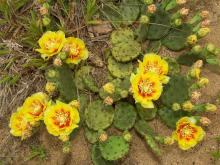Wildflowers, Grasses and Other Nonwoody Plants
Media

Species Types
Scientific Name
Verbascum thapsus
Description
Mullein immigrated to America along with Europeans, and with them it has spread across the continent. Its fuzzy, green-gray rosettes of leaves and tall spikes of yellow flowers make it easy to identify.
Media

Species Types
Scientific Name
Verbascum blattaria
Description
Moth mullein is a native of Eurasia introduced to our continent in the early 1800s. Since then, it has spread across North America. It’s named because the fuzzy flower, with 2 antennalike stamens, looks something like a moth.
Media

Species Types
Scientific Name
Oenothera speciosa
Description
A low-growing wildflower that can colonize large areas along roadsides, showy evening primrose bears pink or white flowers that seem too large for the vegetation that supports them.
Media

Species Types
Scientific Name
Ranunculus hispidus
Description
Hispid buttercup is a densely hairy plant with showy yellow flowers. It is found mostly in the southern half of Missouri, usually in moist locations.
Media

Species Types
Scientific Name
Uvularia grandiflora
Description
A common spring wildflower found in forests nearly statewide, large bellwort has bell-shaped flowers that droop downward. The yellow petals sometimes look twisted, almost wilted.
Media

Species Types
Scientific Name
Ranunculus harveyi
Description
A slender little buttercup growing in rocky, dry areas with acidic soils, Harvey’s buttercup occurs mostly in southern Missouri. One key to identify it is to examine the basal and stem leaves, which are quite different.
Media

Species Types
Scientific Name
Physaria filiformis (formerly Lesquerella filiformis)
Description
Missouri bladderpod is a small, yellow-flowered member of the mustard family that is found only in southwest Missouri. It gets its name from the spherical fruits or “bladders” that contain seeds.
Media

Species Types
Scientific Name
Monotropa hypopitys
Description
Pinesap is a plant that puts the "wild" in wildflower! It lacks chlorophyll, so its roots connect to fungi underground and absorb nutrients from the fungi.
Media

Species Types
Scientific Name
Opuntia humifusa (formerly O. compressa)
Description
Cacti make us think of the desert southwest, but there is at least one species native to Missouri. This prickly pear grows in glades, sand prairies, rocky open hillsides, and other dry, sun-soaked areas.
Media

Species Types
Scientific Name
Oenothera biennis
Description
True to its name, common evening primrose is the most common and widespread evening primrose in Missouri. It is most noticeable late in the season, when it reaches its greatest height and the flowers at the top are most visible.
See Also
About Wildflowers, Grasses and Other Nonwoody Plants in Missouri
A very simple way of thinking about the green world is to divide the vascular plants into two groups: woody and nonwoody (or herbaceous). But this is an artificial division; many plant families include some species that are woody and some that are not. The diversity of nonwoody vascular plants is staggering! Think of all the ferns, grasses, sedges, lilies, peas, sunflowers, nightshades, milkweeds, mustards, mints, and mallows — weeds and wildflowers — and many more!





















